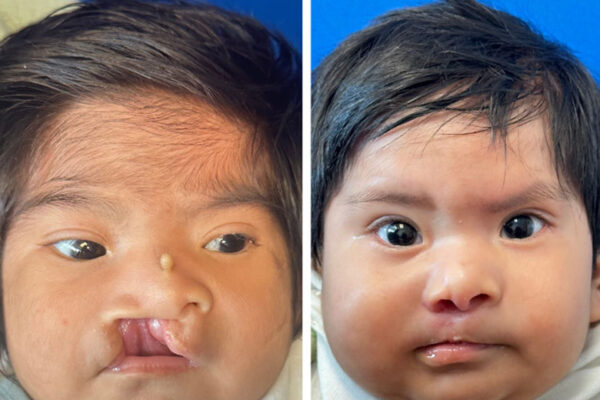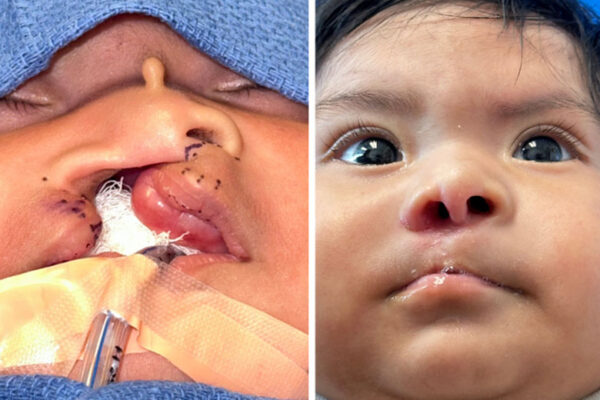Reconstructive surgery offers solutions for individuals seeking to restore the form and function of their nasal, facial, and ear structures following trauma or surgery. Dr. Artur Fahradyan also addresses skin cancer excisions after a patient receives MOHS surgery, which restores optimal aesthetics.
Reconstructive Surgery
Restore Optimal Form & Function
Reconstructive surgery is a specialized branch of plastic surgery that aims to restore facial features, function, and aesthetics following trauma, congenital deformities, or tumor removal. Dr. Fahradyan uses various techniques, such as tissue grafts, flaps, and microsurgery, to rebuild facial structures like the nose, cheeks, and jaw. This enhances facial appearance and improves the patient’s quality of life, ultimately rebuilding confidence and self-esteem.

Goals of Reconstructive Surgery:
- Repair fractures, lacerations, and injuries sustained from accidents, falls, or assaults
- Address birth defects like cleft lips and palates and ear malformations
- Restore optimal facial appearance and function after MOHS surgery for skin cancer removal
- Rebuild the nose after injuries, congenital anomalies, or cancer excisions
- Correct deformities or losses of the outer ear due to trauma or birth defects
- Minimize the visibility of scars from prior surgeries or injuries
- Reconstruct the missing or underdeveloped ear in patients with microtia
Facial Trauma Repair
Facial trauma repair is a crucial component of reconstructive surgery that focuses on restoring the form and function of facial structures following accidents, injuries, or other traumatic events. Dr. Fahradyan uses precise techniques to repair fractures, lacerations, and soft tissue damage to achieve optimal facial symmetry and function. This often involves intricate procedures, such as bone realignment, tissue grafts, and microsurgery, to ensure optimal outcomes.
Treatment for Congenital Deformities
Treating congenital deformities involves specialized reconstructive procedures that correct structural abnormalities present at birth. Depending on the specific deformity, surgical techniques like cleft lip and palate repair or ear reconstruction for microtia may be used. These procedures improve the appearance and function of affected areas, enabling individuals to lead more fulfilling and confident lives while addressing congenital deformities.
Skin Cancer Reconstruction
Skin cancer reconstruction is a vital aspect of reconstructive surgery that focuses on restoring the appearance and function of skin and underlying tissues after removing skin cancer lesions, often using MOHS surgery. Dr. Fahradyan uses various techniques, including skin grafts, flaps, and tissue rearrangement, to close the surgical wound. The goal is to minimize scarring, maintain natural contours, and ensure optimal cosmetic results.

Nasal Reconstruction
Nasal reconstruction is a specialized branch of reconstructive surgery that aims to restore the form and function of the nose following trauma, congenital anomalies, or cancer excisions. Dr. Fahradyan uses various techniques to rebuild the nasal structure, such as cartilage grafts, skin flaps, and tissue rearrangement. This procedure improves aesthetics and enhances breathing and overall facial balance.
Ear Reconstruction
Ear reconstruction is a highly specialized area of reconstructive surgery dedicated to restoring the appearance and function of the ear, particularly in cases of congenital deformities, traumatic injuries, or ear cancer excisions. Dr. Fahradyan uses various techniques, like cartilage grafts and tissue flaps, to reconstruct the external ear. The goal is to recreate a natural-looking ear that enhances appearance and improves hearing.
Cleft Lip & Palate Reconstruction
Cleft lip and palate reconstruction is a comprehensive and multi-faceted approach to address congenital conditions where a child is born with a split or gap in the upper lip (cleft lip) and/or a separation in the roof of the mouth (cleft palate). The primary goal of cleft lip and palate reconstruction is to provide affected individuals with an improved facial appearance, as well as the ability to eat, speak, and breathe normally. Dr. Fahradyan uses a series of surgical procedures usually starting in infancy and continuing into adolescence or even adulthood. These interventions are tailored to each patient’s unique needs, focusing not only on physical correction but also on the emotional and psychological well-being of those living with these conditions.
Scar Revision
Scar revision is a surgical or non-surgical procedure to minimize the visibility of scars resulting from prior surgeries, injuries, or other causes. Dr. Fahradyan uses techniques like excision, laser therapy, dermabrasion, or tissue rearrangement to improve the appearance and texture of scars. This helps make scars less noticeable, enhancing a person’s overall aesthetic appearance and self-confidence. The method depends on the type and location of the scar.
Microtia Repair
Microtia repair focuses on correcting the congenital condition known as microtia, where a child is born with an underdeveloped or absent external ear. Dr. Fahradyan may use cartilage grafting, tissue sculpting techniques, and MedPor microtia reconstruction to create a new, natural-looking ear structure. This improves aesthetic appearance and helps enhance hearing and the overall quality of life for individuals with microtia, allowing them to regain confidence.
Reconstructive Surgery Preparation Guidelines:
- Schedule a consultation with Dr. Fahradyan to discuss your goals and medical history.
- Complete a thorough medical evaluation to ensure you are a suitable candidate for surgery.
- Collaborate with Dr. Fahradyan to create a personalized treatment plan for your needs.
- Understand the potential risks and complications associated with the chosen procedure.
- Adhere to preoperative guidelines regarding medications, diet, and lifestyle changes.
- Organize post-surgery care and transportation for assistance during recovery.
- If you smoke, quit to improve healing and reduce surgical risks.
- Ensure adequate hydration before surgery for a smoother recovery.
- Make necessary adjustments at home for comfort during the initial recovery phase.
- Have prescribed medications, wound care supplies, and comfortable clothing on hand.
- Abstain from eating or drinking for the specified time before surgery.
- Inform your surgeon of any last-minute concerns or changes in your health.
Reconstructive Surgery Aftercare Guidelines:
- Regularly inspect surgical incisions for signs of infection, swelling, or abnormal changes.
- Take prescribed medications as directed for pain management and infection prevention.
- Ensure ample rest to support the body’s healing process.
- Elevate the surgical site, when applicable, to reduce swelling and improve circulation.
- Follow wound care instructions meticulously to promote proper healing.
- Maintain adequate hydration to support overall recovery and tissue healing.
- Consume a balanced diet rich in nutrients to aid the healing process.
- Refrain from smoking, as it can hinder healing and increase complications.
- Restrict strenuous activities as recommended by your surgeon.
- Use pain management techniques, such as prescribed pain relievers or cold packs.
- Keep incisions clean and protect them from sun exposure to prevent scarring.
- Promptly notify your surgeon of any unexpected symptoms or concerns.
Reconstructive Surgery FAQs
What is the difference between reconstructive and cosmetic surgery?
Reconstructive surgery focuses on restoring form and function to correct abnormalities resulting from injury, congenital conditions, or disease, whereas cosmetic surgery enhances or rejuvenates a person’s appearance for aesthetic reasons.
Will there be visible scars after reconstructive surgery?
While Dr. Fahradyan aims to minimize scarring, some scars may be unavoidable. Scar appearance depends on various factors, including the procedure performed, surgical technique, and your body’s healing response.
Can reconstructive surgery improve function as well as appearance?
Absolutely. Reconstructive surgery not only focuses on enhancing aesthetics but also on restoring or improving functionality. This includes procedures to address impaired speech, compromised breathing, or compromised sensory function.
What are the potential risks associated with reconstructive surgery?
Like all surgeries, the risks include infection, bleeding, scarring, anesthesia-related complications, and poor surgical outcomes. However, these risks are typically outweighed by the potential benefits. Dr. Fahradyan takes all necessary precautions to mitigate risks.
How long does the recovery period typically last after reconstructive surgery?
Recovery times vary depending on the procedure’s complexity and individual factors. Some may require a few weeks, while others might extend to several months. Your surgeon will provide personalized guidance on your expected recovery timeline.

Why Choose Dr. Artur Fahradyan?
Dr. Artur Fahradyan is a plastic surgeon board-certified by the American Board of Plastic Surgery with a residency in plastic and reconstructive surgery from the University of Southern California. From the moment you walk through our doors to your full recovery, your comfort, safety, and satisfaction are our priorities. We invite you to schedule a consultation with Dr. Fahradyan to discuss your needs and explore how our knowledge of reconstructive surgery can help you achieve your desired results.


